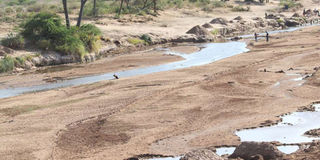Climate change means more rain, but less water in rivers

A section of the drying River Ewaso Nyiro on the border of Isiolo and Marsabit, 2017. PHOTO| PHOEBE OKALL
Soaring temperatures driven by climate change are whipping up ever more intense storms inundating cities with flash floods but leaving the countryside and crucial agricultural land parched, a new study published in Nature Scientific Reports has found.
Researchers from Australia found that while hotter weather sparked heavier storms leading to floods in built up areas, it also reduces moisture in the soil, which then quickly absorbs any excess and reduces water flow in rural rivers.
“So when the big rainfall events do fall, a bigger proportion of them are stored up in the soil, so you have a lesser proportion coming out as flows,” said professor of hydrology Ashish Sharma who was involved in the study.
Experts say decreases in waterways in farming areas threatens agriculture and food security, requiring urgent attention amid a forecast rise in the global population by 23 per cent to nine billion over the next two decades. Meanwhile, they point out that city infrastructure is struggling to cope with the harsher downpours, with flood damage worldwide costing more US$50 billion in 2013 — a figure expected to double in the next 20 years.
“People are increasingly migrating to cities, where flooding is getting worse. At the same time, we need adequate flows in rural areas to sustain the agriculture to supply these burgeoning urban populations,” said the paper’s lead author Conrad Wasko.
The extensive analysis is based on data from nearly 50,000 rain and river monitoring sites across 160 countries. Whereas extreme “once in a lifetime” floods are causing increasingly large water flows, regular cyclical inundations are having less and less of an effect on the water table.
He added that even though the increase in intensity of storms varied around the globe, a persistent finding in the research was that more rain did not translate to more water in river systems.
The paper’s authors said engineering solutions were required to adapt to the change in environment.
“In places like Arizona, or California, the Netherlands, or the Snowy Mountains Scheme (Australian hydroelectricity system), we felt that the way the natural system was working was not consistent with where we want the population to be so we engineered an outcome, and we are benefiting from all the work that was done so many years ago,” Sharma explained.



